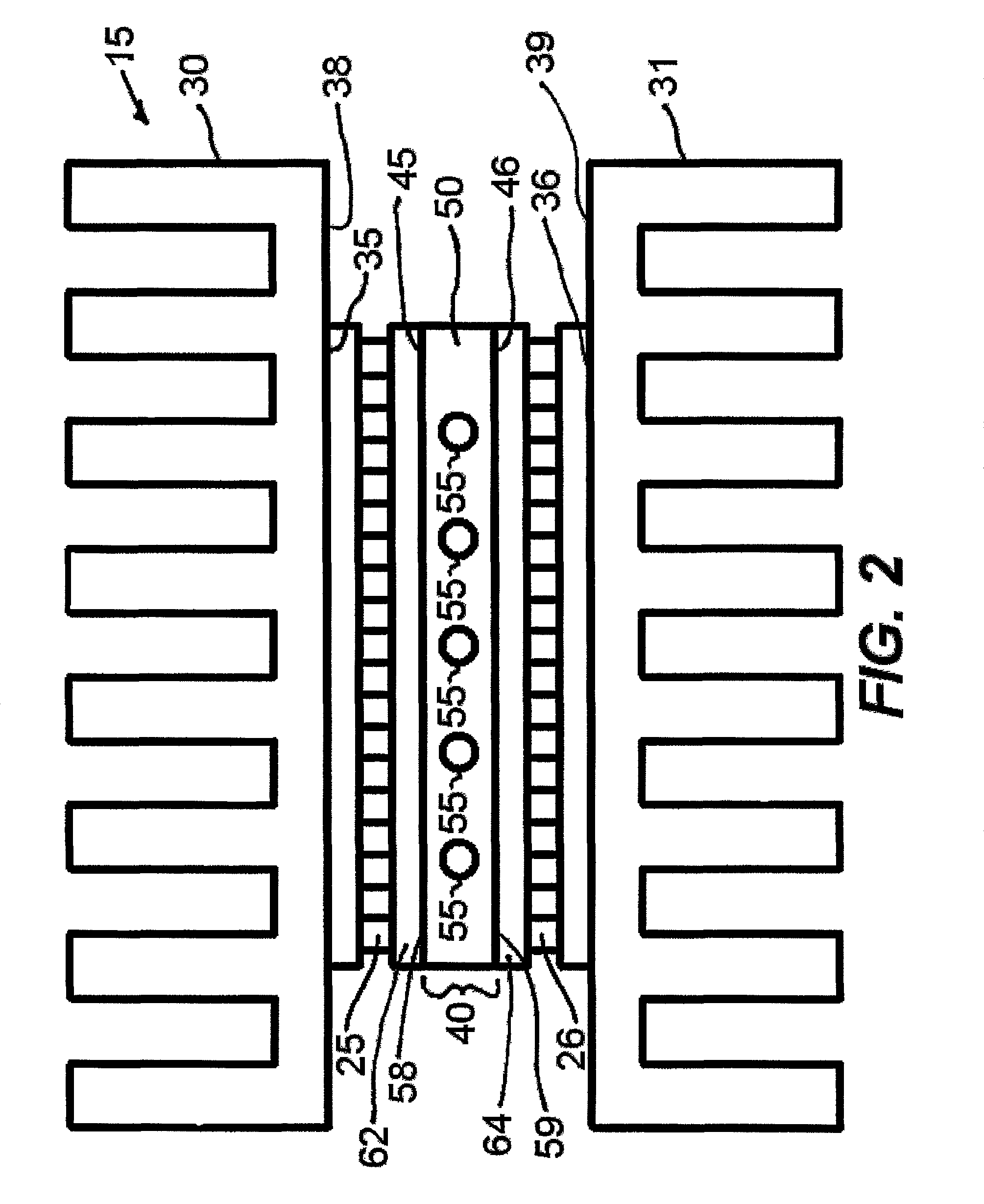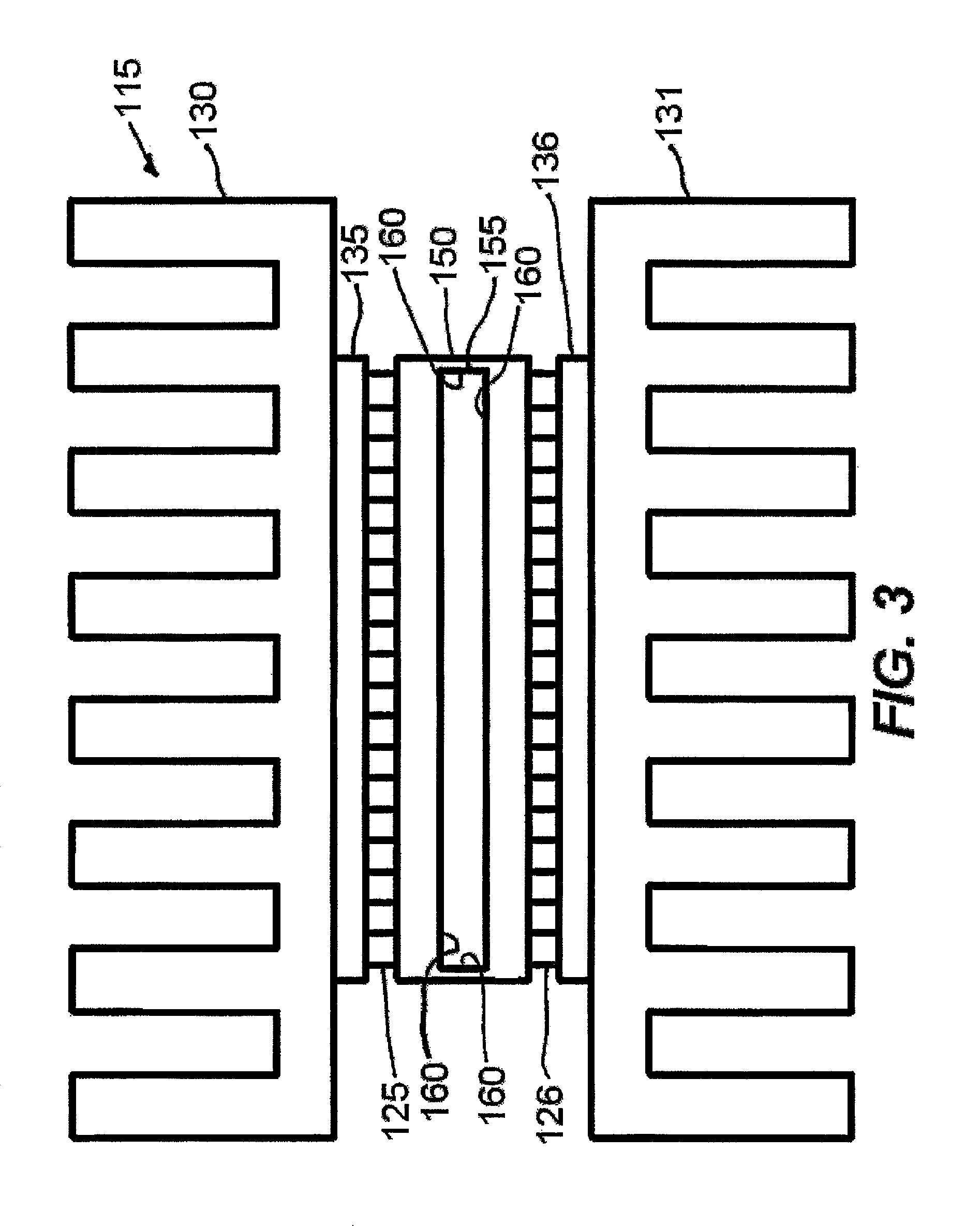Thermocycler and sample vessel for rapid amplification of DNA
a sample vessel and dna technology, applied in the field of sample vessels, can solve the problems of slow ramp rate, long minimum temperature hold time, slow speed of the device, etc., and achieve the effects of high thermal conductivity, good heat pumping efficiency, and dissipation of hea
- Summary
- Abstract
- Description
- Claims
- Application Information
AI Technical Summary
Benefits of technology
Problems solved by technology
Method used
Image
Examples
example 1
30 PCR Cycle Amplification of a 163 bp Product in 5:55 (355 Seconds) Using Glass Capillaries
[0059]To demonstrate the rapid thermocycling of the invention, experiments were carried out in the thermocycler apparatus or system of the present invention to amplify a 163 bp product from lambda bacteriophage DNA (New England Biolabs) in thin-walled glass capillary tubes (Roche Applied Science). Each 25 μL reaction mixture consisted of 5 mM MgSO4, 400 μg / ml BSA, 0.2 mM dNTPs, 0.7 μM each forward and reverse primers, 1×KOD reaction buffer, and 0.5 U of KOD Hot-Start-Polymerase (Novagen). Starting template DNA concentrations were either 500 pg or 20 pg, while negative controls were absent of starting template. Samples were processed in two separate runs (two 500 pg samples along with negative control ran simultaneously, two 20 pg samples with negative control run simultaneously). The cycling assembly used is illustrated in FIG. 2. The thermocycler was programmed to conduct a 30 second hot-sta...
example 2
30 PCR Cycle Amplification of a 402 bp Product in 8:58 (538 Seconds) Using Glass Capillaries
[0060]Experiments were carried out in the thermocycler apparatus or system of the present invention to amplify a longer 402 bp product from lambda bacteriophage DNA in thin-walled glass capillary tubes. The reaction composition was the same as in Example 1, except that different forward and reverse primers were used to generate the 402 bp product. A slightly more conservative protocol was run (30 second hot-start at 94° C., followed by 30 cycles of [94° C. for 2 sec, 60° C. for 2 sec, and 72° C. for 3 sec], and a final extension at 72° C. for 5 sec). The temperature versus time profile of the protocol is shown in FIG. 9A. The total runtime for the protocol was 538 seconds. After amplification, reaction products were separated on a 1% agarose gel stained with EtBr using 6 μL each of the products and a 100 bp molecular weight reference ladder (New England Biolabs). FIG. 9B shows the gel electro...
example 3
30 PCR Cycle Amplification of a 163 bp Product in 5:00 (300 Seconds) Using Plastic Deformable Cylindrical Vessels
[0061]In this example, a sample vessel as illustrated in FIG. 6 and slotted cycling assembly of FIG. 3 was used with a thermocycler apparatus or system of the present invention. The vessel was made out of polypropylene with a wall thickness of about 200 μm. In its native configuration, the vessel was approximately circular in cross section with a diameter of about 8 mm. When inserted into the 1 mm thermocycler slot, each vessel deformed into a flat oval rod with substantial contact with the inner substrates of the thermoelectric modules. The reaction composition was the same as Example 1 but without BSA: 5 mM MgSO4, 0.2 mM dNTPs, 0.7 μM each forward and reverse primers, 1×KOD reaction buffer, and 0.5 U of KOD Hot-Start-Polymerase. The starting template amount per sample was 500 picograms. Reaction volumes were 50 μL (negative control), 50 μL, 50 μL, 100 μL, and 150 μL. Mu...
PUM
| Property | Measurement | Unit |
|---|---|---|
| distance | aaaaa | aaaaa |
| distance | aaaaa | aaaaa |
| temperature | aaaaa | aaaaa |
Abstract
Description
Claims
Application Information
 Login to View More
Login to View More - R&D
- Intellectual Property
- Life Sciences
- Materials
- Tech Scout
- Unparalleled Data Quality
- Higher Quality Content
- 60% Fewer Hallucinations
Browse by: Latest US Patents, China's latest patents, Technical Efficacy Thesaurus, Application Domain, Technology Topic, Popular Technical Reports.
© 2025 PatSnap. All rights reserved.Legal|Privacy policy|Modern Slavery Act Transparency Statement|Sitemap|About US| Contact US: help@patsnap.com



